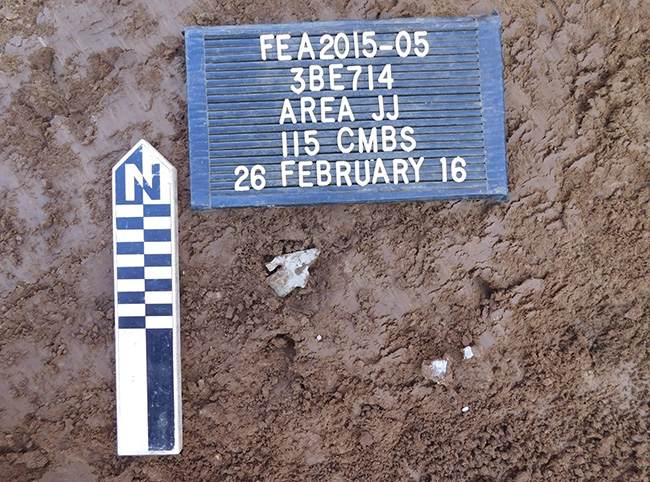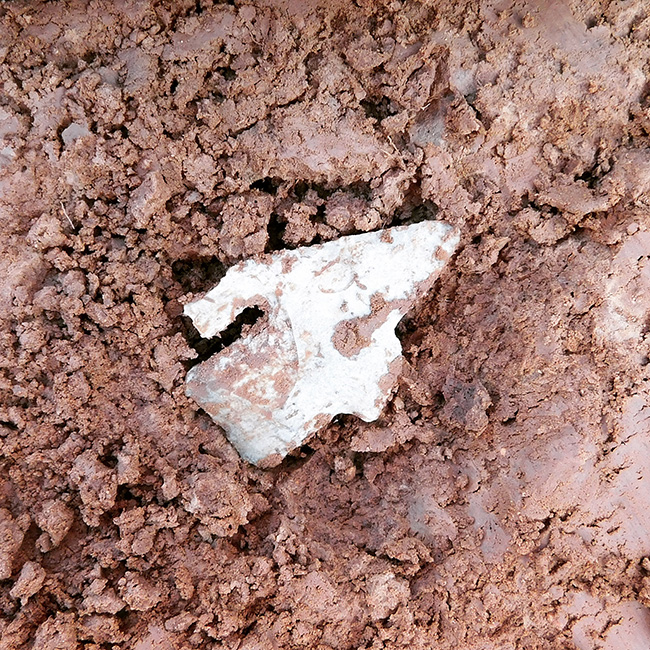
Pritam Chowdhury (Flat Earth Archeology, LLC)
Artifact of the Month - June 2021
This broken, heavily resharpened Calf Creek projectile point (Figures 1, 2, 3) was recovered during archeological excavations on the Hudson East site (3BE714) in Benton County, Arkansas. It is made of Keokuk chert and has a triangular blade with a slightly expanding stem. The base is slightly concave with the deep narrow notches characteristic of this type. The point is missing a large portion of the blade and one barb and has been partially reworked. The point weighs 11.7 g and has a total length of 53 mm.

Flat Earth Archeology, LLC conducted mitigation work on two archeological sites in Northwest Arkansas, Hudson East (3BE714) and Hudson West (3BE906), under a contract with the Arkansas Highway and Transportation Department (now Arkansas Department of Transportation). The sites were discovered during a Phase I archeological survey ahead of a proposed road project in 2008–2009. Phase II testing conducted in 2013–2014 revealed the intact archeological deposits and the significance of the sites. Phase III mitigation excavations were proposed when it was determined that a highway construction project would damage the sites. This fieldwork was conducted and completed in 2015–2016, and the final analysis was completed in 2017. The multiyear, large-scale salvage project determined that these sites possessed an extended record of human occupation spanning the Late Paleoindian through Mississippi periods, ca. 10,500–500 years before present. Of particular importance at the Hudson East site were intact Calf Creek deposits consisting of distinct piles of flint knapping debris, thermal features, and chipped stone tools in various stages of manufacture, use, and discard.
The distinctive Calf Creek points are widely distributed across the Southern Plains and western Ozarks at temporary camps and other special purpose sites, like hunting and butchering stations. Earlier reports associated Calf Creek with the Early Archaic period (Dickson 1970:74; O’Brien 1985:73; O’Brien and Wood 1998:138; Perino 1985:62). While regional use of terms such as “Early Archaic” and “Middle Archaic” may differ, multiple radiocarbon dates from Oklahoma and Texas provide consistent dates for Calf Creek components ca. 5960–5700 cal BP (Lohse et al. 2021). Radiocarbon samples from Calf Creek contexts at the Hudson East site were sent to Beta Analytic for AMS dating and were calibrated using the IntCal20 curve (Reimer et al. 2020). The Hudson East dates range from ca. 5600 to 5800 cal BP, consistent with the established time ranges for Calf Creek found in adjacent regions.

These dates coincide with a climatically benign part of the otherwise hot and dry altithermal or hypsithermal climatic episode (Wyckoff et al. 2009; Wyckoff 2010). Regions such as the Ozarks received more precipitation and the soil conditions improved. Expanding grasslands helped bison to flourish. This, along with abundant lithic raw materials for stone tool production, made the region especially attractive during this period. Calf Creek hunter-gatherers used the Hudson sites in northwest Arkansas in a narrow sliver of time within the Mid-Holocene. The recovery of dozens of exhausted Calf Creek points coupled with numerous heat-treated Reeds Spring chert lithic debitage cache/concentration features suggest that Calf Creek people brought cores of lithic material to the site and left with complete points or preforms. The Hudson sites in Northwest Arkansas offer us a rare and detailed look at Calf Creek occupations in the Interior Highlands region of south-central North America.
For information about this artifact, the archeology of the Hudson sites, and the Calf Creek culture look out for our chapter entitled Calf Creek Hunter-Gatherers in the Southern Ozarks: Mid-Holocene Deposits at Hudson East (3BE714) and Hudson West (3BE906) in Northwest Arkansas, by Pritam Chowdhury, Chris Branam, and Eric Mills in the forthcoming book Calf Creek Horizon: Middle Holocene Hunter-Gatherers on the Southern Plains and Its Margins. edited by Jon Lohse, Don Wyckoff, and Marjorie Duncan and published by Texas A & M Press, College Station, Texas. Expected in 2021.
Materials: Keokuk chert
Dimensions: The point weighs 11.7 g and has a total length of 53 mm. The blade length is 39 mm with a shoulder width of 35 mm and a blade thickness of 7 mm. The stem is 19 mm and a base width of 22 mm. There is a basal thickness of 6 mm.
Age Estimate: Middle Archaic period (5800-5600 rcybp)
Courtesy of: Flat Earth Archeology, LLC
References and Additional Reading
Branam, Chris M.
2014a Memorandum of Agreement Among the Federal Highway Administration, Arkansas Highway and Transportation Department, and Arkansas State Historic Preservation Officer.
2014b Treatment Plan for Prehistoric Archeological Sites 3BE714 and 3BE906 for the Springdale Highway 412 Northern Bypass, Benton County, Arkansas. Flat Earth Archeology Project Number 2013-70, submitted to the Arkansas Highway and Transportation Department for AHTD Job No. CA0907.
Branam, Chris M. and Eric R. Mills, Pritam Chowdhury, Jane Carmack, and Zachary Burt
2017 Final Report: Phase III Archeological Data Recovery Of Sites 3BE714 (Hudson East) And 3BE906 (Hudson West) For The Springdale Highway 412 Northern Bypass, Benton County, Arkansas (Vol. I-III). Flat Earth Archeology Project Number 2015-05. Prepared for: Arkansas Highway and Transportation Department Environmental Division. Job CA0907 Hwy 112-I-49(S) FAP No. 991 Task Order 109.
Chowdhury, Pritam and Chris Branam, and Eric Mills
2021 Calf Creek Hunter-Gatherers in the Southern Ozarks: Middle Holocene deposits at Hudson East (3BE714) and Hudson West (3BE906) in Northwest Arkansas. In Calf Creek Horizon: Middle Holocene Hunter-Gatherers on the Southern Plains and Its Margins, edited by Jon Lohse, Don Wyckoff, and Marjorie Duncan. Texas A & M Press, College Station, Texas. In press.
Dickson, Don R.
1968 Two Provisional Point Types: The Arkansas Amateur 7:5–7.
1970 Excavations at Calf Creek Cave. The Arkansas Archeologist 11:50–82.
1991 The Albertson Site: A Deeply and Clearly Stratified Ozark Bluff Shelter. Research Series No. 41. Arkansas Archeological Survey, Fayetteville.
Duncan, Marjorie, and Don G. Wyckoff
1994 The McKellips Site: An Analysis of the Calf Creek Component. Bulletin of the Oklahoma Anthropological Society 34:83–141.
Lohse, Jon, Don Wyckoff, and Marjorie Duncan (editors)
2021 Calf Creek Horizon: Middle Holocene Hunter-Gatherers on the Southern Plains and Its Margins. Texas A & M Press, College Station, Texas. In press.
O'Brien, Michael
1985 Radiocarbon Dates. In Archaeology of the Central Slat River Valley: An Overview of the Prehistoric Occupation, by Michael J. O’Brien, pp. 67–75. The Missouri Archaeologist 46.
O'Brien, Michael and W. Raymond Wood
1998 The Prehistory of Missouri. University of Missouri Press, Columbia.
Perino, Gregory
1985 Selected Preforms, Points and Knives of the North American Indians. Volume 1. Points and Barbs Press. Idabel, Oklahoma.
Ray, Jack H
2016 Projectile Point Types in Missouri and Portions of Adjacent States. Missouri Archaeological Society, Special Publications No. 10.
Ray, Jack H. and Neal H. Lopinot
2003 Middle Archaic Components and Chert Use at the Bass Site. Missouri Archeological Society Quarterly 20 (2):4–16.
Reimer, Paula J, et al.
2020 The IntCal20 Northern Hemisphere Radiocarbon Age Calibration Curve (0–55 Cal KBP). Radiocarbon 62(4):725–757. doi:10.1017/RDC.2020.41
Sandstrom, Carl B., and Jack H. Ray
2004 A Point Identification Guide for Southwest Missouri. Ozarks Chapter of the Missouri Archaeological Society. Springfield, Missouri.
Thurmond, J. P., and Don Wyckoff
1999 The Calf Creek Horizon in Northwestern Oklahoma. Plains Anthropologist 44:231–250.
Wyckoff, Don G.
1984 The Foragers: Eastern Oklahoma. In Prehistory of Oklahoma, edited by Robert Bell. Academic Press, Orlando, Florida.
1993 A Summary of the Calf Creek Horizon in Oklahoma. Bulletin of the Oklahoma Anthropological Society, Vol XLII.
2010 Hunter-Gatherer Chert Use along the Southwest Flank of the Ozarks. The Missouri Archaeologist 71.
 Collections and items in our institution have incomplete, inaccurate, and/or missing attribution. We are using this notice to clearly identify this material so that it can be updated, or corrected by communities of origin. Our institution is committed to collaboration and partnerships to address this problem of incorrect or missing attribution. For more information, visit localcontexts.org.
Collections and items in our institution have incomplete, inaccurate, and/or missing attribution. We are using this notice to clearly identify this material so that it can be updated, or corrected by communities of origin. Our institution is committed to collaboration and partnerships to address this problem of incorrect or missing attribution. For more information, visit localcontexts.org.
 The Arkansas Archeological Survey is committed to the development of new modes of collaboration, engagement, and partnership with Indigenous peoples for the care and stewardship of past and future heritage collections.
The Arkansas Archeological Survey is committed to the development of new modes of collaboration, engagement, and partnership with Indigenous peoples for the care and stewardship of past and future heritage collections.
 The TK Notice is a visible notification that there are accompanying cultural rights and responsibilities that need further attention for any future sharing and use of this material. The TK Notice may indicate that TK Labels are in development and their implementation is being negotiated. For more information about the TK Notice, visit localcontexts.org.
The TK Notice is a visible notification that there are accompanying cultural rights and responsibilities that need further attention for any future sharing and use of this material. The TK Notice may indicate that TK Labels are in development and their implementation is being negotiated. For more information about the TK Notice, visit localcontexts.org.
